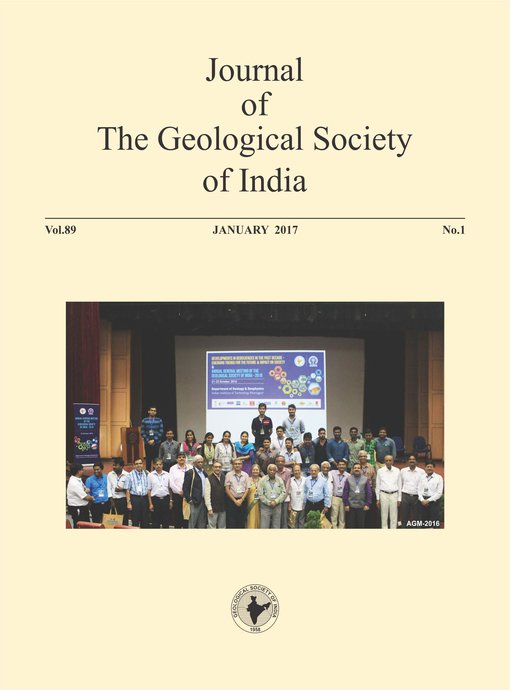An Insight into Slope Stability Using Strength Reduction Technique
DOI:
https://doi.org/10.1007/s12594-017-0561-7Abstract
In Shear strength reduction (SSR) technique, the factor of safety (FOS) is defined as the ratio of the material's actual shear strength to the minimum shear strength required to prevent failure. Failure surface is found automatically through the zones within the material, where applied shear stresses cross the shear strength of the material. In this paper, a review of the technique is discussed in reference to FLAC. A brief background of the approach together with detailed procedure is presented. An attempt is made to exhibit the shear strength dependency of the strain. As stability of the slope is a function of the shear strength, the development of failure strain reflects the potential failure zone of slope. The shear strain developed in the slope increases with reduction in the shear strength and is reflected in the analysis. The concept of failure ratio (Rf) is incorporated in shear strength reduction technique and is demonstrated. Relationships between the critical shear strength reduction ratio and the safety factor are examined.Downloads
Metrics
Issue
Section
Downloads
Published
How to Cite
References
Asef, M.R. and Reddish, D.J. (2002) The impact of confining stress on the rock deformation modulus. Geotechnique, v.52, pp.235-241.
Cala, M. and Flisiak, J. (2003) Slope stability analysis with numerical and limit equilibrium methods. In: Burczynski, Fedelinski & Majchrzak (Eds.) Computer Methods in Mechanics, CMM-2003.
Cheng, Y.M., Lansivaara, T. and Wei, W.B. (2007) Two-dimensional slope stability analysis by limit equilibrium and strength reduction method. Computers and Geotechnique, v.34, pp.137-150.
Dawson, E.M., Roth, W.H. and Drescher, A. (1999) Slope stability analysis by strength reduction. Geotechnique, v.49, pp.835-840.
Donald, I.B. and Giam, S.K. (1988) Application of the nodal displacement method to slope stability analysis, Proceedings of the 5th Australia-New Zealand Conference on Geomechanics, Sydney, Australia, Aug. 22-26.
Duncan, J.M. and Chang, C.Y. (1970) Non-linear analysis of stress and strain in soil. Jour. Soil Mechanics and Foundation Engg., ASCE, v.5, pp.16291652.
Duncan, J.M., 1996, State of the art: limit equilibrium and finite-element analysis of slopes. Jour. Geotechnical and Geoenvironmental Engg., ASCE, v.122, pp.577-596.
Griffiths, D.V. and Lane, P.A. (1999) Slope stability analysis by finite elements. Geotechnique, v.49, pp.387-403.
Itasca Consulting Group Inc. (2001) Fast Lagrangian Analysis of Continua, FLAC Version 4, User's Manuals.
Janbu, N. (1963) Soil compressibility as Determined by Oedometer and Triaxial tests, European Conference on Soil mechanics and Foundation Engg., Wiesbaden, Germany, 1, pp.19-25.
Kainthola, A., Singh, P.K., Wasnik, A.B., Sazid, M. and Singh, T.N. (2012) Finite element analysis of road cut slopes using Hoek & Brown failure criterion, IJEE, v.5(5) pp.1100-1109.
Lechman, J.B. and Griffiths, D.V. (2000) Analysis of the progression of failure of earth slopes by finite elements. Slope stability proceedings of sessions of Geo-Denver, Aug.5–8.
Maji, V. B. (2008) Strength and deformation behaviour of jointed rocks, Ph.D thesis, Indian Institute of Science, Bangalore, 253p.
Maji, V.B. and Sitharam, T.G. (2010) Stability of slope based on shear strain criterion and its dependency on shear strength, EUROCK Proceedings, EPFL, Switzerland, June 15-18.
Matsui, T. and San, K.C. (1992) Finite element slope stability analysis by shear strength reduction technique. Soils and Found., v.32, pp.59–70.
Naylor, D.J. (1981) Finite elements and slope stability, Numerical methods in Geomechanics, proceedings of the NATO advanced study institute, Lisbon, Portugal, pp.229-244.
Roscoe, K.H., 1970, The influence of strains in soil mechanics. Tenth Rankine lecture, Geotechnique, v.20, pp.129-170.
Singh, P.K., Wasnik, A.B., Kainthola, A., Sazid, M., Singh, T.N. (2013) The stability of road cut cliff face along SH-121- A case study, Natural Hazard, v.68(2), pp.497-507.
Ugai, K. and Leshchinsky, D. (1995) 3-dimensional limit equilibrium and finite element analyses: A comparison of results. Soils and Found., v.35, pp.1-7.
Ugai, K. (1989) A method of calculation of total factor of safety of slopes by elasto-plastic FEM, Soils and Foundations, v.29, pp.190-195.
Zheng, H., Sun, G. and Liu, D. (2009) A practical procedure for searching critical slip surface of slopes based on the strength reduction. Computers & Geotechnique, Elsevier, v.36, pp.1–6.
Zheng, Y.R., Zhao, S.Y., Kong, W.X., and Deng, C.J. (2005) Geotechnical engineering limit analysis using Finite Element Method. Rock and Soil Mechanics, v.26, pp.163-168.
Zienkiewicz, O.C., Humpheson, C. and Lewis, R.W. (1975) Associated and non-associated viscoplasticity in soil mechanics. Geotechnique, v.25, pp.671-689.

 V. B. Maji
V. B. Maji






